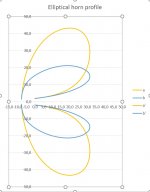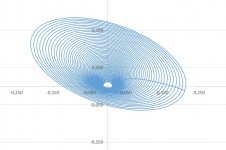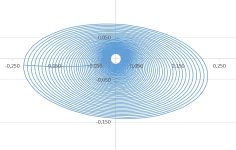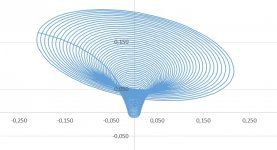Dear all!
After my mixed experiences with round traxtrix horns the question came to my mind how the radiation could be more focused to the horizintal plane. As I was always fascinated of the orginal Klangfilm publications and the math behind it I thought some time how to change the design to an elliptical one. Now, I think that I have fond a solution and would like to share this but only for diy use! For any commercial use, please conatct me! A lot of work was put into this calculator!
The round horns produce considerable beaming - too much for my taste... On the other hand such horns does not have any diffrations zones and therefore many point out the natural sound character. This smooth transition without any sudden diffrations zones should be retained.
What I do not want are discussions that other horn designs are better!
Maybe not all you are aware that the original Klangfilm profile is closed. Nealry all real desings terminate the profile near the mouth. Therefore, the constraint must be that any existing stretch factor must be zero at beginning and at end of the determing x-coordinate. It took a long time until I found a quite good working sinus dependend transformation from round to elliptical.
It was already a hard to work to implement the original round formulas in Excel VBA. The 3D to 2D projections were taken from the web. There exist several examples how to do that. I wanted to have the horn profile visible and rotable for my eyes.
The original design assumes the wave front to be a spherical surface cap. The math to calculate this surface is quite simple. If we transform this to elliptical the math is not simple anymore. So far as I found there do not exist any natural expressions to solve the integral of the surface of an tri-axial ellipsoidal surface cap. The only way is a numerical integration what I have implemented and I think it works quite nicely now.
How does it work? At eny point along the horn axis, first the original round values are calculated. Then the dependend stretch factor is calculated which is max at the maximum rollback of the horn profile. Two possibilities exist to stretch the xy coordinates multiply or divide. I choosed to devide one of the coordinates of the ellipse which gives better looking profiles. This is easy to understand if you look at how to invest some money into shares (stock exchange). You can loose normally only 100% of your capital but can gain more than 100% of your capital
At every point, after calculating the stretch or compression factor for one elliptical coordinate the other is numerically optimized by a Newton optimizaton to yield the same ellipsoidal cap surface as for the round horn by numerically calculate the first derivative with respect to the change of the other elliptical coordinate. As starting point the 2D surfaces are assumed to be equal which is not the case for 3D but already numerically very near to the real value. Perfect for the Newton iteration.
The stretch factor should be greater than 1. The sheet produces a complete set of xyz coordinates on Sheet2 for the resulting horn. I hope to receive some feedback how to transform these xyz coordinates to an 3D printable format or input format.
Sadly, I assume that this sheet only works with Micorsoft Excel VBA.
After my mixed experiences with round traxtrix horns the question came to my mind how the radiation could be more focused to the horizintal plane. As I was always fascinated of the orginal Klangfilm publications and the math behind it I thought some time how to change the design to an elliptical one. Now, I think that I have fond a solution and would like to share this but only for diy use! For any commercial use, please conatct me! A lot of work was put into this calculator!
The round horns produce considerable beaming - too much for my taste... On the other hand such horns does not have any diffrations zones and therefore many point out the natural sound character. This smooth transition without any sudden diffrations zones should be retained.
What I do not want are discussions that other horn designs are better!
Maybe not all you are aware that the original Klangfilm profile is closed. Nealry all real desings terminate the profile near the mouth. Therefore, the constraint must be that any existing stretch factor must be zero at beginning and at end of the determing x-coordinate. It took a long time until I found a quite good working sinus dependend transformation from round to elliptical.
It was already a hard to work to implement the original round formulas in Excel VBA. The 3D to 2D projections were taken from the web. There exist several examples how to do that. I wanted to have the horn profile visible and rotable for my eyes.
The original design assumes the wave front to be a spherical surface cap. The math to calculate this surface is quite simple. If we transform this to elliptical the math is not simple anymore. So far as I found there do not exist any natural expressions to solve the integral of the surface of an tri-axial ellipsoidal surface cap. The only way is a numerical integration what I have implemented and I think it works quite nicely now.
How does it work? At eny point along the horn axis, first the original round values are calculated. Then the dependend stretch factor is calculated which is max at the maximum rollback of the horn profile. Two possibilities exist to stretch the xy coordinates multiply or divide. I choosed to devide one of the coordinates of the ellipse which gives better looking profiles. This is easy to understand if you look at how to invest some money into shares (stock exchange). You can loose normally only 100% of your capital but can gain more than 100% of your capital
At every point, after calculating the stretch or compression factor for one elliptical coordinate the other is numerically optimized by a Newton optimizaton to yield the same ellipsoidal cap surface as for the round horn by numerically calculate the first derivative with respect to the change of the other elliptical coordinate. As starting point the 2D surfaces are assumed to be equal which is not the case for 3D but already numerically very near to the real value. Perfect for the Newton iteration.
The stretch factor should be greater than 1. The sheet produces a complete set of xyz coordinates on Sheet2 for the resulting horn. I hope to receive some feedback how to transform these xyz coordinates to an 3D printable format or input format.
Sadly, I assume that this sheet only works with Micorsoft Excel VBA.
Attachments
I had to break-up the calculation of the VBA not to exceed the file upload limits here.
To draw the profile it is bets to go to Sheet1, change the desired input paramters and start the VBA draw_klangfilm. To view a 3D projection of the resulting horn, go to Sheet2 and start RotateAB.
The xyz coordinates can be found on Sheet2.
Sheet3 contains more or less debug infos.
It is possible to stop the calculation for either a or b of the ellipsoid without rollback or at any given point of the profile. For the given example here of 343 Hz cut-off this limit is around 31 cm.
Currently, I have retained the message boxes at some points of the profile. The VBA stops at any message box and continues after clicking away the box.
Be aware that a lot of number crunching is working in the background VBAs! So, the speed may be quite small to calculate the whole profile.
The original step size is roughly the length of the horn devided by the number of steps. But there is a built-in adjustable step size. Effectively, the step size is reduced around the mouth as the radius changes the most here and at the end where the profile closes but this will never reached because of a threshold value. The end of the profile should be more or less of only academic nature.
Best regrads and have fun with this!
Bernd
To draw the profile it is bets to go to Sheet1, change the desired input paramters and start the VBA draw_klangfilm. To view a 3D projection of the resulting horn, go to Sheet2 and start RotateAB.
The xyz coordinates can be found on Sheet2.
Sheet3 contains more or less debug infos.
It is possible to stop the calculation for either a or b of the ellipsoid without rollback or at any given point of the profile. For the given example here of 343 Hz cut-off this limit is around 31 cm.
Currently, I have retained the message boxes at some points of the profile. The VBA stops at any message box and continues after clicking away the box.
Be aware that a lot of number crunching is working in the background VBAs! So, the speed may be quite small to calculate the whole profile.
The original step size is roughly the length of the horn devided by the number of steps. But there is a built-in adjustable step size. Effectively, the step size is reduced around the mouth as the radius changes the most here and at the end where the profile closes but this will never reached because of a threshold value. The end of the profile should be more or less of only academic nature.
Best regrads and have fun with this!
Bernd
Attachments
Last edited:
This is a good start. There is still much to consider.
A very helpful comment.....
I am not sure if you have realized that this is a mathematically exact transformation of the round spherical dome cap to a tri-axial ellipsoid surface cap following the original publication of the spherical wave horn (Klangfilm). Nothing else was in the scope as to transform the round profile to an elliptical one by preserving the assumptions made for the spherical wave horn.
If you say that much is still to consider you should be able to say what aspects should be mentioned?
I'm sure it is accurate.. You have made the horizontal wider, and the vertical shorter, now the mouth ends on a flat plane. The vertical will be narrow only at a higher frequency, and then at lower frequencies it will become wider than the horizontal.
You have made horn loading the most important thing to stay the same as the original round horn. Is loading a more important part of the spherical horn, or directivity? If you choose a different spherical profile for the vertical, it will be longer than the horizontal and it will keep the directivity right down to the same low frequency.
You have made horn loading the most important thing to stay the same as the original round horn. Is loading a more important part of the spherical horn, or directivity? If you choose a different spherical profile for the vertical, it will be longer than the horizontal and it will keep the directivity right down to the same low frequency.
Great stuff.
Note that symmetrical horns suffer from peaks and dips which are caused by the symmetry. All horns suffer from reflections, you can minimize them but you can't eliminate them 100%. The problem with symmetrical horns is that these reflections *all happen at the same time.* (Because the pathlengths in a symmetrical horn are identical.)
So anything that you can do to break up that symmetry is A Good Thing. If you look at the newer JBL designs, they're not just using asymmetrical horns, *even the phase plug is asymmetrical.* So the asymmetry starts at the diaphragm and goes from there.
Charles Sprinkle described it like this:
"“The Bi-Radial horn that we have had for decades was a 90x60 horn, and not the best match for the low frequency device in the M2,” Sprinkle says. “This horn is 120 degrees horizontal and 110 degrees vertical. We knew that if we wanted a good directivity transition between the woofer and the high frequencies, we had to have that amount of pattern, so the waveguide was designed to have a pattern consistent with what the woofer was doing with no discontinuity at the crossover point, which is 800 Hz.
“The second thing we did was use a blending geometry—there are no straight lines, you’ll notice—that has a generally decreasing radius,” he continues, “forming an infinite number of reflections, and the net effect is that it smears the reflections coming back down the horn and negates them.
“The third thing we did is bring these ‘knuckles,’ which is a name that sort of stuck, in from the side so that rather than having this 1.5-inch aperture that we had in the Bi-Radial design, we were able to get the upper pattern control frequency up near 10k, much like it would be with a 25mm dome. You combine that with a high-frequency device that has the internal damping characteristics this driver has, and it sounds like a silk-dome! That nice, sweet, effortless, open sound. In the process, that directivity characteristic in the mid-band went away. Alan was really a champion of doing the right thing with the architecture: driver placement, making the cabinet taller—that opened the door to the work that was done on the waveguide.”
Note that symmetrical horns suffer from peaks and dips which are caused by the symmetry. All horns suffer from reflections, you can minimize them but you can't eliminate them 100%. The problem with symmetrical horns is that these reflections *all happen at the same time.* (Because the pathlengths in a symmetrical horn are identical.)
So anything that you can do to break up that symmetry is A Good Thing. If you look at the newer JBL designs, they're not just using asymmetrical horns, *even the phase plug is asymmetrical.* So the asymmetry starts at the diaphragm and goes from there.
Charles Sprinkle described it like this:
"“The Bi-Radial horn that we have had for decades was a 90x60 horn, and not the best match for the low frequency device in the M2,” Sprinkle says. “This horn is 120 degrees horizontal and 110 degrees vertical. We knew that if we wanted a good directivity transition between the woofer and the high frequencies, we had to have that amount of pattern, so the waveguide was designed to have a pattern consistent with what the woofer was doing with no discontinuity at the crossover point, which is 800 Hz.
“The second thing we did was use a blending geometry—there are no straight lines, you’ll notice—that has a generally decreasing radius,” he continues, “forming an infinite number of reflections, and the net effect is that it smears the reflections coming back down the horn and negates them.
“The third thing we did is bring these ‘knuckles,’ which is a name that sort of stuck, in from the side so that rather than having this 1.5-inch aperture that we had in the Bi-Radial design, we were able to get the upper pattern control frequency up near 10k, much like it would be with a 25mm dome. You combine that with a high-frequency device that has the internal damping characteristics this driver has, and it sounds like a silk-dome! That nice, sweet, effortless, open sound. In the process, that directivity characteristic in the mid-band went away. Alan was really a champion of doing the right thing with the architecture: driver placement, making the cabinet taller—that opened the door to the work that was done on the waveguide.”
Hello Allen!
Neither the original profile nor the changed profiles mouth ends in a flat plane. You might have not understand the profile. The whole profile is closed. Only the constraint to end the calculation at max length of the horn ends in flat plane. Until here it is comparable to the round JMLC horn.
There are two designs that inspired my work. The 18s XT1464 und much more the Faital Pro LTH142. The last one is an elliptical tractix.
The spherical wave horn has a quite good reputaion and it was never my intention to create something similar to E-JMLC or Iwate or similar. If you are other opinion we would be happy if you share your results.
To break symmetry was an aditonal intention to distort into an elliptical profile.
Neither the original profile nor the changed profiles mouth ends in a flat plane. You might have not understand the profile. The whole profile is closed. Only the constraint to end the calculation at max length of the horn ends in flat plane. Until here it is comparable to the round JMLC horn.
There are two designs that inspired my work. The 18s XT1464 und much more the Faital Pro LTH142. The last one is an elliptical tractix.
The spherical wave horn has a quite good reputaion and it was never my intention to create something similar to E-JMLC or Iwate or similar. If you are other opinion we would be happy if you share your results.
To break symmetry was an aditonal intention to distort into an elliptical profile.
It just looks like it from the images in post #4. The section of post #1 shows the true closed shape, right?Neither the original profile nor the changed profiles mouth ends in a flat plane. You might have not understand the profile.
How would you build such a thing?
Yes, post #1 I set a flat surface against the blue and yellow trace on my screen. This is not the end of the profile but I think I see it showing the method used to make this transformation. Anyway, perhaps changing spherical wavefront to ellipsoidal, and presenting the right horn for that new shape are two separate issues?
If your reason was to break symmetry then you may have done this well, and the compromise is justified. 18s and Faital Pro (not picking on them), can you imagine how popular it would be if they decided to sell a radial horn, what would people do with it?
The tractrix, LeCleach, spherical family have good strengths (some are also weaknesses), so it can be the best choice when those strengths are prioritized for the job.
If your reason was to break symmetry then you may have done this well, and the compromise is justified. 18s and Faital Pro (not picking on them), can you imagine how popular it would be if they decided to sell a radial horn, what would people do with it?
The tractrix, LeCleach, spherical family have good strengths (some are also weaknesses), so it can be the best choice when those strengths are prioritized for the job.
The 18s XT1464 und much more the Faital Pro LTH142.
Another interesting horn is the one from Ciare. It does also have an elliptical shape but it extends more or less conically in the horizontal plane while its vertical expansion is such that the area grows with a hypex function. I guess it behaves a little like all those (in)famous radial horns regarding radiation pattern but with less diffraction.
Regards
Charles
There are two designs that inspired my work. The 18s XT1464 und much more the Faital Pro LTH142. The last one is an elliptical tractix.
Do you know the entrance angle of the Faital Pro? The curves look very nice.
Hi Allen!
There is a space limitation for attachments just below 1MB, so I could not attach the Excel which contains the full calculation/values and curves. if an admins allows me to attach maybe 3MB more things should become clear.
These round horns have drawbacks - no questions. But I am fascinated of the math/construction that is behind the Klangfilm profile. Not easy to understand or obvious on the first view how the profile is constructed and why it closes.
But there are still people who buy these horns from Poland or Jabo (Eckhorn) I would assume that these follow a very similar profile. Btw, setting the stretch factor to 1 calculates the original round profile.
I cannot proof that the elliptical transformation would beam less. But if I look at the Failta Pro and also the Ciare these horns similarly miss the diffraction areas near the throat. I have measured the Faital Pro's imdedance and frequency responses which look very smooth.
There was a question how to produce such an horn. We are in the century of 3D printing. There are even horns which come directly out of printers like the Azzolinas. For this I am searching for suggestions how to transform the xyz coordinates to 3D printer software input files.
In order to let appear the whole profile maybe a little bit clearer please look at the attachment here as snapshot of only one orientation. In my eyes it would be one of the coolest looking horns ever produced with nearly full rollback (the whole on the back side just as large to allow a driver to be mounted).
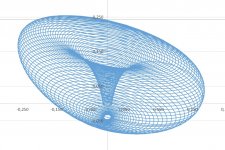
There is a space limitation for attachments just below 1MB, so I could not attach the Excel which contains the full calculation/values and curves. if an admins allows me to attach maybe 3MB more things should become clear.
These round horns have drawbacks - no questions. But I am fascinated of the math/construction that is behind the Klangfilm profile. Not easy to understand or obvious on the first view how the profile is constructed and why it closes.
But there are still people who buy these horns from Poland or Jabo (Eckhorn) I would assume that these follow a very similar profile. Btw, setting the stretch factor to 1 calculates the original round profile.
I cannot proof that the elliptical transformation would beam less. But if I look at the Failta Pro and also the Ciare these horns similarly miss the diffraction areas near the throat. I have measured the Faital Pro's imdedance and frequency responses which look very smooth.
There was a question how to produce such an horn. We are in the century of 3D printing. There are even horns which come directly out of printers like the Azzolinas. For this I am searching for suggestions how to transform the xyz coordinates to 3D printer software input files.
In order to let appear the whole profile maybe a little bit clearer please look at the attachment here as snapshot of only one orientation. In my eyes it would be one of the coolest looking horns ever produced with nearly full rollback (the whole on the back side just as large to allow a driver to be mounted).

Last edited:
Do you know the entrance angle of the Faital Pro? The curves look very nice.
Sorry, I do not know it. But these numbers are to some degree questionable for me. For my 18s driver I know from the factory that the opening angle is only a few degs and not a plane wave.
The spherical horn is similar to tractrix/LeCleach but it opens quicker. This family of horns has the benefit of loading well. This is a positive unless you want to run the horn below cutoff, then it can be a negative.
This comes with the effect of constantly widening directivity. This is a positive when you want to make a transition, otherwise it can be a negative. The horn needs free space to follow its curve.
Diffraction happens consistently, which is a positive when you want to shed directivity. This shedding alters the wavefront shape until it reaches behind.
These effects should be looked upon as coincidental in my opinion. Making a choice when to use this type of horn can allow decisions to be made on the priorities.
This comes with the effect of constantly widening directivity. This is a positive when you want to make a transition, otherwise it can be a negative. The horn needs free space to follow its curve.
Diffraction happens consistently, which is a positive when you want to shed directivity. This shedding alters the wavefront shape until it reaches behind.
These effects should be looked upon as coincidental in my opinion. Making a choice when to use this type of horn can allow decisions to be made on the priorities.
Last edited:
The spherical horn is similar to tractrix/LeCleach but it opens quicker.
This is not correct. They all are only similar at throat regions. The spherical wave horn (Kugelwellenhorn) is approximately similar to LeCleach from throat to near mouth where they begin to differ while the sperical wave horn approches the closing and finds it's end at 2 * r0. Beyond this it has no mathematical solution. Nothing to say anymore about LeCleah in this forum I believe.
The Tractrix curve was already discovered in the 17th century. And the construction is totally different as the calculation begins at the mouth while the spherical wave horn begins at the throat. I have also programmed the tractrix curve in Excel. Very easy to do that.
Do you know the entrance angle of the Faital Pro? The curves look very nice
I could not find that out so far although I have searched for it as well. But interestingly all published FR measurements of Faital 1.4" drivers are performed on that horn. Although not all 1.4" Faital Drivers have the same exit angle.
The Faital horn looks a little prettier than the XT1464 but I guess it will not load as low as the XT1464. That - and someone from this forum (was it AllenB ?) who also had good experiences - made me go with the XT1464 for my Faital HF146 drivers for my "kitchen loudspeakers".
Regards
Charles
I've seen the dip peak in symetrical horn, like the jbl sp212a, oasr horn but ripples in jbl's pdf.
Post 55
Flattest response between 2000hz - 20 000hz - Page 4
jbl sp212a - Google Search
I've been looking at the pt h1010hf waveguide that some like, there is even a newer one in plastic for under $70 (1.5" jbl). I notice jbl uses a 3khz notch with it. It is square 100 x 100 but looks fairly smooth walled for not being round.
JBL 442730-001 PTH1010HF-1 Waveguide - Speaker Exchange
Older pt 100x100
Something Old with Something New
Post 55
Flattest response between 2000hz - 20 000hz - Page 4
jbl sp212a - Google Search
I've been looking at the pt h1010hf waveguide that some like, there is even a newer one in plastic for under $70 (1.5" jbl). I notice jbl uses a 3khz notch with it. It is square 100 x 100 but looks fairly smooth walled for not being round.
JBL 442730-001 PTH1010HF-1 Waveguide - Speaker Exchange
Older pt 100x100
Something Old with Something New
Last edited:
- Home
- Loudspeakers
- Multi-Way
- Klangfilm spherical wave horn calculator - from round to elliptical
